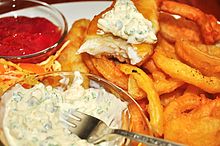Tartar sauce
 Tartar sauce is often served with fried seafood. | |
| Alternative names | Tartare |
|---|---|
| Type | Sauce |
| Place of origin | Europe |
| Main ingredients | Mayonnaise, capers, gherkins, lemon juice, and tarragon |
Tartar sauce (in the UK, New Zealand and Australia, tartare sauce) is a mayonnaise or aioli-based sauce, typically of a rough consistency. It is often used as a condiment with seafood dishes.[1]
Composition
Tartar sauce is based on either mayonnaise (egg yolk, mustard or vinegar, oil) or aioli (egg yolk, olive oil, garlic, lemon juice), with certain other ingredients added. In the UK, recipes typically add to the base capers, gherkins, lemon juice, and dill. US recipes may include chopped pickles or prepared green sweet relish, capers, onions (or chives), and fresh parsley.[1] Chopped hard-boiled eggs or olives are sometimes added, as may be Dijon mustard and cocktail onions.[2] Paul Bocuse describes sauce tartare explicitly[3] as a sauce remoulade,[4] in which the characterising anchovy purée is to be substituted by some hot Dijon mustard.
History and etymology

The sauce and its name have been found in cookbooks since the 19th century. The name derives from the French sauce tartare, named after the Tatars (Ancient spelling in French of the ethnic group: Tartare) from the Eurasian Steppe, who once occupied Ukraine and parts of Russia.[5] In fact, the Tatars have nothing directly to do with either the sauce or steak tartare (raw beef steaks often served with components of the sauce). "Tartar" was the Persian name for the Mongols of Genghis Khan, whom Europeans of their time viewed as uncivilized, particularly for their practice of eating meat raw. In French cuisine, the phrase á la tartare thus became used to refer to a "variety of highly seasoned dishes" and forms of undercooked meat, so the sauce may have received its name for the pungency of its original version.[6] Especially in the Haute cuisine era, dish names were frequently selected from contemporary, fashionable, public issues to gain attention.[citation needed]
An idea of what people in the nineteenth century meant by naming something "tartar" can be found in a recipe of Isabella Beeton in "The Book of Household Management" of 1861, recipe no. 481, "Tartar mustard", made of horseradish vinegar, cayenne and ordinary mustard. In her recipe no. 503, "Remoulade, or French Salad-Dressing", she describes a preparation with tarragon that can hardly be identified with a Remoulade as standardized by Auguste Escoffier forty years later or as it is considered today. But she explains that the tarragon for her recipe of "Green Remoulade" comes originally from Tartary. In the days of Tsarism, the Russian properties in Asia south of Siberia were frequently called Tartary, especially when an exotic undertone was intended. Sauce Tartare might be a descriptive term for a tarragon mayonnaise named after the origin of the so-called Russian tarragon, which actually is rarely used for culinary purposes.
In 1903 Auguste Escoffier gave a recipe for Sauce Remoulade (Rec. No. 130[7]) with both mustard and anchovy essence, but he used only the term Sauce Tartare for it in the rest of the book. This is still common use in Austria and former Austrian regions like Bohemia, where Sauce Remoulade and Sauce Tartare are synonyms on restaurant menus. The German dictionary "Langenscheidt, Maxi-Wörterbuch Englisch, 120.000 Phrases of 2002" identifies Tartar(e) Sauce as Remouladensosse.
In the early era of the Haute Cuisine from about 1890 to the outbreak of World War I in 1914 minced filet of beef was dressed with Sauce Tartare and served raw as Boeuf Tartare or steak tartare[8] with regard to the sauce's name.[9] Between the World Wars, until today, it came into fashion to serve the dish with regard to the raw unprocessed meat just with the unprocessed ingredients of the sauce.
See also
References
- ^ a b Isabella Graham Duffield Stewart, Mary B. Duffield (1878). The Home messenger book of tested receipts. Detroit: E. B. Smith & Co. p. 31. Retrieved 2 June 2012.
- ^ Louisette Bertholle, Julia Child, Simone Beck (1961, 1983, 2001). Mastering the Art of French Cooking. Vol. 1. New York: Alfred A. Knopf. ISBN 978-0-307-95817-4. Retrieved 2 June 2012.
{{cite book}}: Check date values in:|year=(help)CS1 maint: multiple names: authors list (link) CS1 maint: year (link) - ^ Paul Bocuse, La cuisine du marché,1976
- ^ Bocuse describes the Remoulade just previous Sauce Tartare as a standard mayonnaise (egg yolks, vinegar, oil) with additional chopped capers, gherkins and herbs and some anchovy purée
- ^ "tartar". Online Etymology Dictionary. Douglas Harper. 2001–2002. Retrieved 2 June 2012.
- ^ Wolke, Robert L. (2002). What Einstein Told His Cook: Kitchen Science Explained. New York: W. W. Norton & Company. p. 102. ISBN 978-0-393-32942-1.
- ^ Auguste Escoffier, A guide to modern Cookery, English 1907 from french origin of 1903
- ^ Craig J. Smith (6 April 2005). "The Raw Truth: Don't Blame the Mongols (or Their Horses)". New York Times. Retrieved 3 June 2012.
- ^ Many dishes of that time were named after Sauce Tartare, because a basic preparation of a meat is accompanied by it, e.g.: Lobsters, Shrimps or Crabs tartare, Poulet a la tartare (Escoffier's recipe no. 1645), Chicks tartare (Escoffier's recipe no. 1649). Other dishes like Salmon Hollandaise or Tournedos Béarnaise (Escoffier's recipe no. 1081) were composed similarly and their names were created by the same system.

